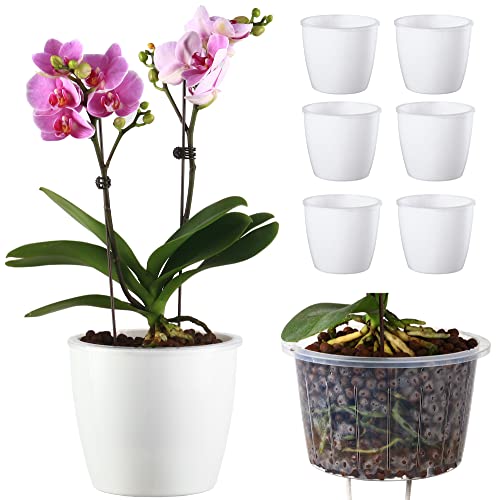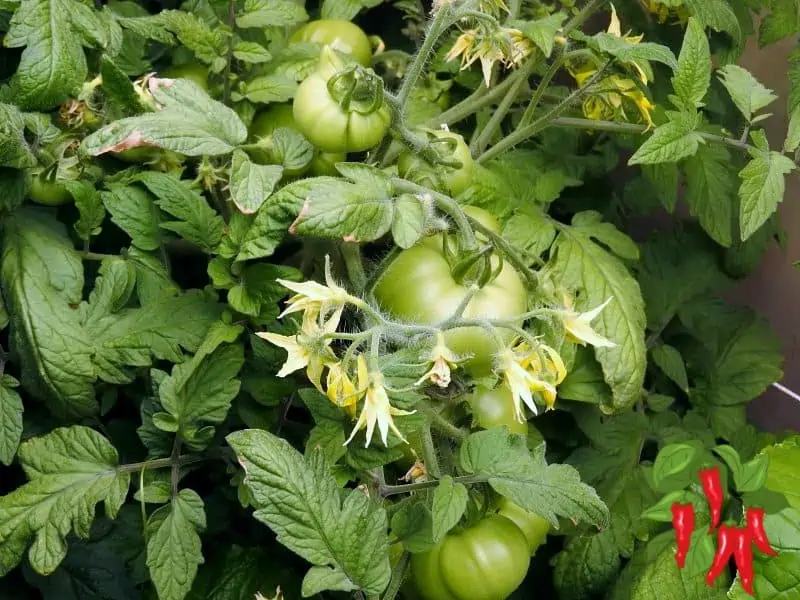This post may contain affiliate links. If you buy something from one of our links we may earn a commission. Thanks
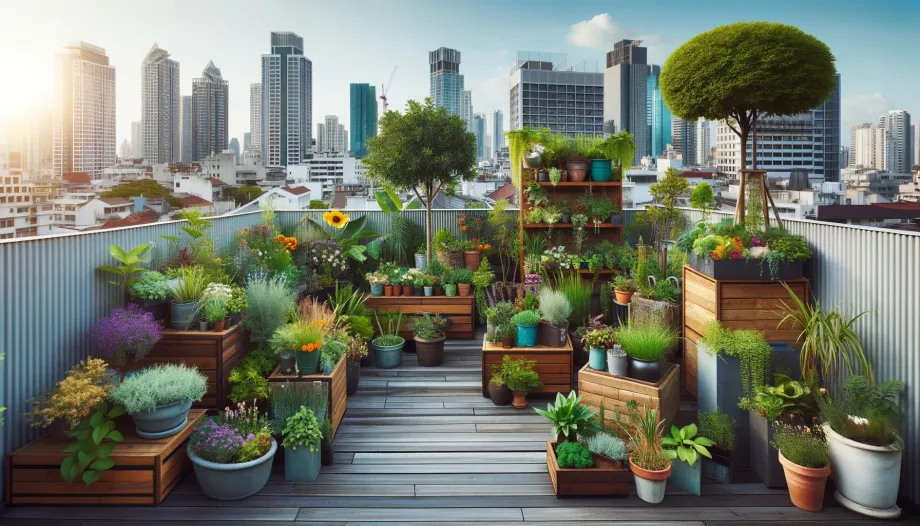
Discover the magic of rooftop gardening containers! Transform your urban space into a lush, green oasis with our expert tips and ideas. Start your rooftop garden adventure today!
Key Takeaways:
- Rooftop gardening containers offer a versatile and space-efficient solution for urban greenery.
- Ideal for growing vegetables, herbs, or flowers, they transform underused roof spaces into productive and beautiful gardens.
- They make city living greener and more sustainable.
Welcome to the world of rooftop gardening containers, where the sky’s the limit for your urban green space!
Whether you’re dreaming of a veggie patch, a floral haven, or a herb sanctuary, our guide will help city dwellers turn that dream into a vibrant reality.
Join us as we explore how to make the most of your rooftop, one container at a time!
An Introduction to Rooftop Gardening Containers
Embark on a journey into the enchanting world of rooftop container gardening, a creative and eco-friendly approach to urban greenery.
This guide introduces the joys and practicalities of cultivating your personal rooftop oasis, promising a delightful transformation of any urban space into a flourishing, leafy retreat.
In a world of limited time and space, container gardens make more and more sense. Containers allow you to enjoy growing plants in places that might be thought of as impossible or unthinkable in which to plant. Poor soil or no place to put plants in the ground is no longer an excuse for not being able to enjoy the simple pleasures of gardening. https://extension.illinois.edu/container-gardens
What Is Rooftop Container Gardening?
Rooftop container gardening, an innovative green solution, is revolutionizing urban landscapes worldwide.
Amidst the concrete and steel of city life, these gardens offer a refreshing burst of nature, turning barren rooftops into blossoming havens.
They not only enhance the beauty of urban spaces but also contribute significantly to environmental health by improving air quality and reducing the urban heat island effect.
The benefits extend beyond aesthetics and ecology; they provide city dwellers with a personal connection to nature, an opportunity for sustainable living, and a space for relaxation and creativity.
Whether it’s a vegetable plot, a flower garden, or a herb corner, rooftop container gardening adapts to various needs, making it an indispensable part of modern urban living.
This practice holds the promise of a greener, more vibrant cityscape, offering a sanctuary in the sky for both people and wildlife.
Key Takeaways
This comprehensive guide to rooftop container gardening will delve into the essentials of creating and maintaining your rooftop garden.
We’ll explore a range of topics including the selection of the best containers, ideal plants for rooftop conditions, and innovative design ideas to maximize your space.
Key takeaways include understanding the importance of container size and material, particularly lightweight options for easy maneuvering and adequate drainage to ensure plant health.
We’ll also discuss creative rooftop planter ideas, essential rooftop garden supplies, and steps to cultivate a thriving rooftop veggie or herb garden.
Additionally, the guide will cover practical aspects like the architectural considerations for a roof garden, techniques for efficient roof gardening, and how to start and maintain a container garden.
Through these insights, you’ll be equipped to transform your urban rooftop into a flourishing garden that not only beautifies your space but also contributes positively to your well-being and the environment.
A Deep Dive into Rooftop Container Gardening
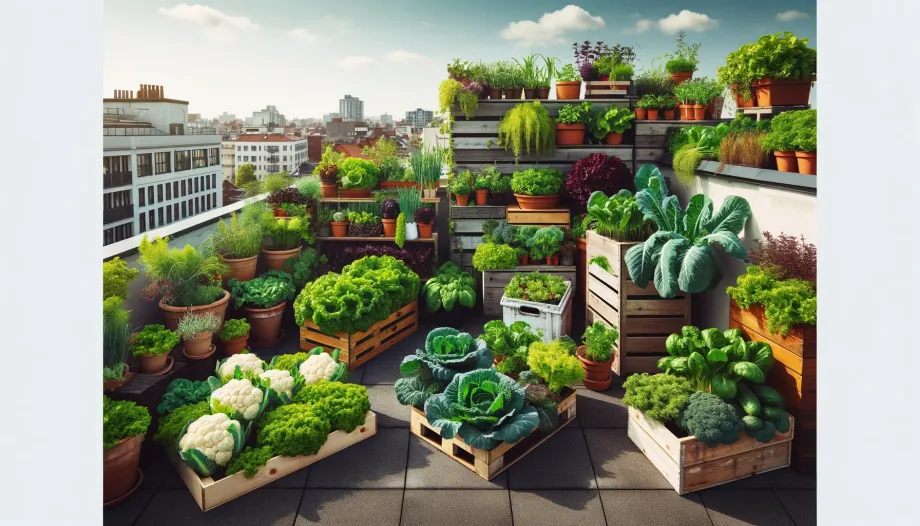
Let’s take a deep dive into the fascinating realm of rooftop container gardening, where every rooftop is a potential green oasis.
In this detailed exploration, we uncover the secrets to transforming your urban skyline into a lush, productive garden, tailored to thrive in the unique environment of city rooftops.
Understanding the Basics of Rooftop Container Gardening
Rooftop container gardening is more than just planting in boxes on a roof; it’s an art and science that brings nature to urban heights.
This gardening style is a beacon of sustainability and resourcefulness, offering city dwellers a chance to cultivate their green thumb in the sky.
What Rooftop Container Gardening Entails
Rooftop container gardening is an innovative approach to urban greening, allowing for a diverse range of plants to be grown in containers strategically placed on rooftops.
This method is ideal for those living in apartments or buildings without traditional garden spaces.
It’s not just about aesthetics; rooftop gardens can provide fresh produce, reduce air pollution, and even help in the temperature regulation of buildings.
From small herb gardens to elaborate floral arrangements, these gardens can be as simple or complex as desired, making them accessible to gardeners of all skill levels.
Importance of Container Selection
Choosing the right container is crucial for the success of a rooftop garden.
Containers for rooftop gardening should be lightweight, durable, and have proper drainage to prevent waterlogging.
Lightweight rooftop planters make it easier to manage and rearrange the garden layout.
Materials like plastic or treated wood are popular choices due to their resilience against the elements.
Size also matters; large rooftop gardening containers are suitable for growing bigger plants or small trees, while smaller ones are perfect for herbs and flowers.
Plant Choice and Environmental Considerations
Plant selection is deeply influenced by environmental factors unique to rooftop settings, such as wind exposure, sunlight, and temperature extremes.
Opting for drought-tolerant plants or those that thrive in full sun can lead to a more successful rooftop garden.
Rooftop veggie gardens and herb gardens are popular choices, offering both utility and beauty.
Understanding the microclimate of your rooftop is essential in choosing plants that will thrive in that specific environment.
Additionally, considering aspects like rooftop garden supplies and the architectural impact of your garden is vital for a harmonious and sustainable rooftop ecosystem.
Site Considerations for Rooftop Gardening
When embarking on rooftop gardening, it’s essential to understand the unique challenges and opportunities your specific site presents.
This understanding is key to creating a sustainable and thriving garden in the sky.
Assessing Roof Space, Light Exposure, and Building Permissions
The first step in rooftop gardening is to assess the available space.
This involves understanding the structural capacity of your roof to support the weight of gardening containers, soil, and plants, especially when considering large or heavy containers.
Light exposure is another critical factor; some roofs may have full sun, ideal for sun-loving plants, while others may be shaded, requiring plants that thrive in less light.
Additionally, it’s essential to seek building permissions. Checking with your landlord or building management is crucial to ensure that your gardening plans align with any building policies or city regulations.
Understanding the Roof’s Condition and Maintenance Requirements
A roof’s condition significantly impacts the type of garden you can create.
Factors such as waterproofing, drainage systems, and roof material should be considered to avoid any potential damage.
Regular maintenance of the roof is also vital to ensure both the safety and longevity of your garden.
This includes routine checks for any leaks or structural damages that could be exacerbated by the added weight or water from the garden.
Understanding these aspects ensures that your rooftop garden is not only beautiful but also a responsible addition to your urban environment.
Choosing the Right Containers
Selecting the appropriate containers is a critical decision in rooftop container gardening, influencing both the health of your plants and the sustainability of your garden.
Factors to Consider: Size, Weight, Material, and Wind Resistance
When choosing containers, size matters for both the plant’s growth and the roof’s capacity.
Larger containers are ideal for extensive root systems but require a roof that can bear their weight, especially when filled with soil and water.
The weight of the container itself is crucial; lightweight rooftop planters are preferred to ease movement and reduce structural strain.
The material of the container also plays a significant role. Durable materials like plastic, fiberglass, resin, or treated wood withstand diverse weather conditions.
Additionally, in windy urban landscapes, containers with wind resistance are essential.
Stable, low-profile designs or those with anchoring systems help prevent tipping or damage.
Recommendations for Different Types of Containers
For windy rooftops, containers with a wider base offer more stability. Rectangular or square containers can be more wind-resistant than round ones.
In contrast, for roofs with limited space, vertical planters or hanging baskets maximize gardening space efficiently.
For those interested in growing vegetables or larger plants, deeper containers with adequate drainage are necessary.
Consider self-watering containers for ease of maintenance, especially for thirsty plants like rooftop veggies and herbs.
Each container type should be chosen based on the specific conditions and limitations of your rooftop space, ensuring a harmonious and thriving garden environment.
Utilizing Self-Watering Planters
Incorporating self-watering planters in rooftop gardening is a smart strategy that can enhance the efficiency and ease of maintaining a rooftop garden, especially for those new to gardening or with busy lifestyles.
Benefits of Using Self-Watering Planters in Rooftop Gardening
Self-watering planters offer numerous benefits that make them ideal for rooftop environments.
They are designed to provide a consistent water supply, crucial for rooftop plants exposed to sun and wind.
These planters typically feature a reservoir at the bottom, which allows plants to absorb water as needed, promoting healthier root growth and preventing water stress.
This system is particularly beneficial for moisture-loving plants and can be a game-changer for rooftop veggie gardens and herb gardens, ensuring that plants receive adequate hydration for optimal growth.
Conserving Water and Simplifying Maintenance
One of the most significant advantages of self-watering planters is their water conservation capability.
They reduce the frequency of watering by storing water and allowing plants to access it over time.
This is especially important in urban settings where water use can be a concern.
Moreover, these planters simplify maintenance, a key consideration for gardeners who may not have the time for daily watering.
By providing a consistent moisture level, they minimize the risk of over or under-watering, making garden care more manageable and less time-consuming.
Overall, self-watering planters are an excellent choice for rooftop gardeners looking to create a low-maintenance, water-efficient, and thriving garden space.
Soil and Planting Considerations
The foundation of a successful rooftop garden lies in choosing the right soil and plants.
These elements are crucial in creating a thriving, vibrant garden in the unique rooftop environment.
Importance of Good Soil and Potting Mixes
For rooftop container gardens, regular garden soil won’t suffice.
Good quality potting mixes are essential as they are specifically formulated to provide the right balance of drainage and water retention, crucial for container gardening.
These mixes often contain a blend of peat, perlite, and compost, providing a lightweight yet nutrient-rich environment for plants.
They also help in preventing soil compaction, which can affect root growth and water drainage.
Investing in a high-quality potting mix is a small step that can significantly impact the health and productivity of your rooftop garden.
Using Coco Coir
Coco coir is an excellent potting medium. It weighs less than potting soil and you can reduce pot size by one-third due to its superior drainage, aeration qualities, and ease of rooting.
It is sustainably sourced and reusable. The only drawback is it provides no nutrients so you must feed plants grown in it.
Selecting Plants Based on Rooftop Conditions and Personal Preferences
When selecting plants for your rooftop garden, consider the specific conditions of your rooftop.
Factors like sun exposure, wind intensity, and temperature extremes will dictate which plants will thrive.
For sunny rooftops, drought-tolerant plants or sun-loving vegetables and herbs can be ideal.
In windier or shaded areas, choose plants that can tolerate such conditions. Additionally, personal preference plays a significant role.
Whether you’re drawn to the practicality of a rooftop veggie garden, the aesthetics of flowering plants, or the convenience of a rooftop herb garden, choose plants that align with your interests and gardening goals.
This personalization not only makes your garden more enjoyable but also ensures that you’re invested in its care and maintenance.
Arranging and Designing Your Rooftop Garden
The arrangement and design of a rooftop garden can transform your space into a personal sanctuary that reflects both your aesthetic preferences and practical needs.
Creative Tips for Arranging Containers
When arranging containers, consider both the visual impact and the garden’s functionality.
Grouping plants with similar sunlight and water needs simplifies maintenance.
Play with varying heights and sizes of containers to create a dynamic, multi-dimensional space.
Utilize vertical planters or trellises to maximize space, especially in smaller areas.
For larger rooftops, create distinct zones – perhaps a dining area surrounded by fragrant herbs and a relaxation corner with lush foliage.
Use container colors and rooftop planter styles that complement each other and your overall design theme, be it a minimalist, tropical, or rustic look.
Design Intent and Personalized Garden Space
Your rooftop garden should be a reflection of your personality and lifestyle. Whether you prefer a space for entertaining, a quiet retreat, or a productive vegetable garden, your design should cater to these intents.
Consider adding personal touches like decorative pots, unique plant species, or DIY elements.
If you entertain often, incorporate seating areas or a small table among the greenery.
For a more meditative space, integrate elements like water features or a small Zen garden.
Remember, your rooftop garden is not just a collection of plants; it’s an extension of your living space, a place where design meets nature to create your personal urban oasis.
Maintaining Your Rooftop Garden
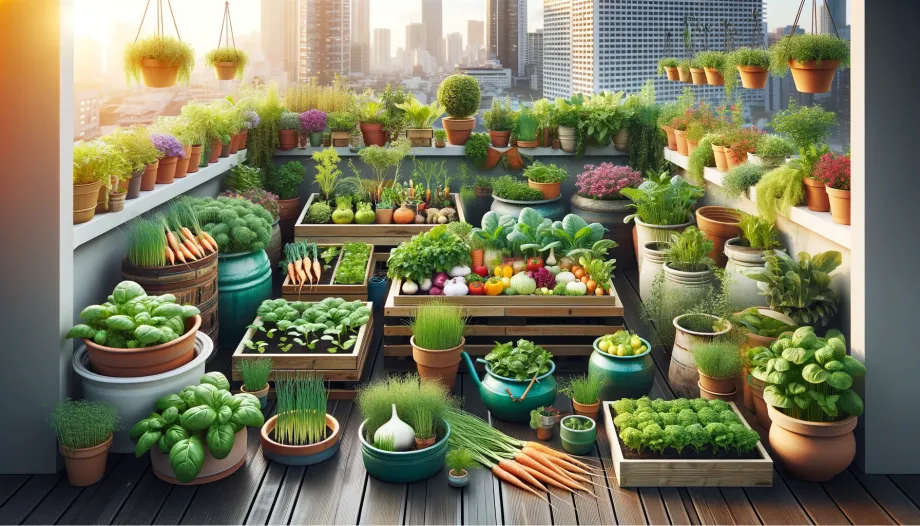
Proper maintenance is key to ensuring your rooftop garden remains a vibrant and healthy retreat amidst the urban landscape.
Understanding the unique challenges and best practices for care will keep your garden flourishing year-round.
Addressing Unique Challenges: Weather Exposure and Limited Resources
Rooftop gardens face distinct challenges, primarily due to their exposure to the elements.
High winds, intense sun, and varying temperatures can stress plants. To mitigate these, choose wind-resistant containers and plants, use shading elements for protection against intense sun, and provide insulation for temperature fluctuations.
Limited resources like water and soil nutrients also require careful management.
Implementing a water-efficient irrigation system, such as drip irrigation or self-watering planters, can be crucial in ensuring consistent moisture, especially for rooftop veggie gardens or herb gardens that require regular watering.
Watering, Fertilizing, and Pest Control Tips
Regular watering is essential, but over-watering can lead to root rot.
Check soil moisture regularly and adjust your watering schedule based on weather conditions.
Fertilizing is also vital as container plants rely solely on what is provided to them. Use a balanced, slow-release fertilizer to maintain nutrient levels.
For pest control, opt for organic or eco-friendly products to avoid harming beneficial insects.
Regularly inspect plants for signs of pests or diseases and treat them promptly to prevent spread.
Incorporating plants that naturally repel pests can be an added advantage.
Remember, consistent observation and timely intervention are key to maintaining a healthy rooftop garden.
Seasonal Care and Adjustments
A rooftop garden, with its exposure to the elements, requires seasonal adjustments in care to ensure its year-round beauty and productivity.
Understanding these seasonal nuances is vital for a thriving garden.
Adjusting Care Routines According to the Changing Seasons
As seasons change, so do the needs of your rooftop garden.
In spring, it’s time to refresh the soil, prune dead foliage, and plant new seedlings.
Summer demands vigilant watering and fertilizing as plants grow vigorously under the strong sun.
Utilizing mulch can help retain soil moisture and keep roots cool.
As autumn approaches, prepare your garden for cooler temperatures by removing spent plants and adding compost to enrich the soil.
Winter Protection Methods and Summer Maintenance Tips
Winter poses a unique challenge, especially in colder climates.
Protect your plants by insulating containers with bubble wrap or burlap and adding extra mulch around plant bases.
Consider moving sensitive plants indoors or into a sheltered area.
For evergreens or hardy plants, ensure they have adequate moisture before the ground freezes.
In summer, regular watering becomes crucial. Early morning or evening watering helps reduce evaporation, and monitoring for pests and diseases is vital due to increased activity during warm months.
By adapting your care routine to the rhythms of the seasons, your rooftop garden can remain a vibrant and enjoyable space throughout the year.
Legal and Safety Considerations
Navigating the legalities and safety aspects is a crucial step in establishing a rooftop garden, ensuring compliance and longevity of your green haven.
Understanding Legal Restrictions and Safety Requirements
Before starting your rooftop garden, it’s essential to understand any legal restrictions that might apply.
This includes checking with local authorities about zoning laws, building codes, and any permits required for rooftop modifications.
In some urban areas, restrictions may govern the size, type, or even the existence of rooftop gardens.
Additionally, safety regulations concerning fire hazards, access routes, and weight limits are critical to comply with to ensure the safety of residents and the building structure.
Checking with Authorities and Ensuring Structural Integrity
Consulting with a structural engineer or a qualified professional is crucial to assess the rooftop’s capacity to hold the weight of containers, soil, plants, and additional features like furniture or water systems.
This step cannot be overlooked, as the added weight and water requirements of a garden could potentially compromise the roof’s structural integrity.
It’s also important to ensure proper drainage to avoid water damage.
Adhering to these legal and safety considerations not only protects you legally but also ensures a secure and sustainable garden environment for everyone to enjoy.
Rooftop Container Gardening FAQs
Rooftop container gardening opens up a world of possibilities for urban dwellers, but it also brings a host of questions.
From the benefits and suitable plants to legalities and maintenance, let’s explore some common inquiries to help you cultivate a thriving rooftop garden.
Q: What Are the Key Benefits of Rooftop Container Gardening?
A: Rooftop container gardening offers numerous benefits. It transforms unused urban spaces into green areas, improves air quality, and reduces the heat island effect in cities.
It also provides a space for growing fresh produce and a serene retreat for relaxation and enjoyment.
Q: Which Plants Are Most Suitable for Rooftop Gardening?
A: The best plants for rooftop gardens include drought-tolerant species, hardy herbs like rosemary and thyme, and sun-loving flowers such as petunias and marigolds.
Vegetables like tomatoes and lettuce also thrive in well-drained containers. The choice depends on the specific conditions of your rooftop, like sunlight exposure and wind levels.
Q: What Should I Consider When Setting Up a Rooftop Garden?
A: Key considerations include assessing the structural strength of the roof, ensuring proper drainage and waterproofing, selecting appropriate containers and plants, and understanding the rooftop’s microclimate.
Also, consider access to water and how you’ll transport materials to your rooftop.
Q: How Do I Maintain My Rooftop Garden?
A: Regular watering (mindful of over and under-watering), fertilizing, and monitoring for pests and diseases is crucial.
Adapt your care routine to seasonal changes, and ensure your plants are adequately protected during harsh weather conditions, especially in winter.
Q: Are There Legal Restrictions or Safety Requirements for Rooftop Gardening?
A: Yes, legal restrictions can include building codes, weight limits, and safety regulations.
It’s essential to check with local authorities and potentially obtain permits.
Safety considerations include ensuring the roof can support the garden’s weight and that there are no fire hazards or obstructions to emergency exits.
Rooftop Gardening Containers Conclusion and Final Thoughts
Embracing Urban Green Spaces: The Transformative Power of Rooftop Gardening
Rooftop container gardens are more than just a trend; they are a transformative force in urban landscapes.
By introducing vibrant greenery to the concrete jungle, these gardens not only enhance the aesthetic appeal of our cities but also play a crucial role in environmental conservation.
They improve air quality, reduce the urban heat island effect, and contribute to biodiversity.
Rooftop gardens are a testament to the resilience of nature and our ability to integrate it into our urban lives, creating healthier, more sustainable living spaces.
Personal and Community Benefits: A Personal Oasis in the Sky
The creation and maintenance of a rooftop garden bring immense personal satisfaction and relaxation.
It’s a peaceful escape from the hustle and bustle of city life, a place where one can connect with nature and find tranquility.
Beyond individual benefits, rooftop gardens foster community spirit and shared spaces in urban settings.
They provide a platform for neighbors to connect, share gardening tips, and even share harvests, strengthening community bonds and promoting a sense of togetherness.
Future Possibilities and Encouragement: Inspiring Future Green Thumbs
This guide is an invitation to envision the potential of your rooftop space, no matter its size.
Rooftop gardening is an accessible and rewarding endeavor, suitable for beginners and experienced gardeners alike.
Start small, experiment, and watch your garden grow over time.
Embrace the challenge and joy of rooftop gardening; it’s an opportunity to contribute to a greener cityscape and to cultivate a little piece of paradise in the sky.
We encourage you to embark on this rewarding journey, nurture your green thumb, and discover the myriad benefits that rooftop gardening has to offer.
More resources:
Visit my Amazon Influencer Page for videos and gardening products Grow Your Own Garden


